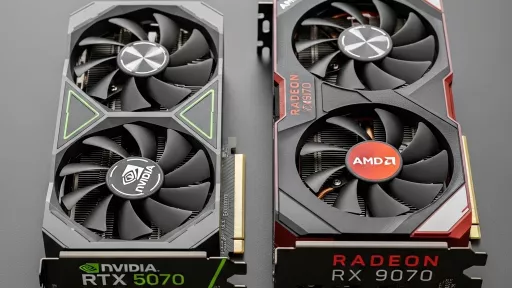Despite AMD’s impressive RDNA 4 architecture, the Radeon RX 9070 isn’t capturing gamers’ attention the way NVIDIA’s RTX 5070 is. Even though both cards launched at similar price points and the RX 9070 technically offers slightly more VRAM, the RTX 5070 continues to outsell it worldwide. Let’s break down why gamers are gravitating toward NVIDIA’s latest offering.
1. Advanced Upscaling with DLSS 4
Upscaling technology has become a cornerstone of modern gaming. Both AMD and NVIDIA offer solutions—FSR 4 and DLSS 4, respectively—but NVIDIA still holds the edge. DLSS 4 not only delivers slightly better visuals but also enjoys wider adoption across games. Nearly twice as many titles currently support DLSS 4 compared to FSR 4, giving the RTX 5070 a clear advantage for smoother, high-resolution gameplay.
Another key feature is Multi-Frame Generation (MFG). While the RX 9070 supports traditional frame generation, the RTX 5070 can use both traditional and MFG, providing more versatility and better fluidity in fast-paced games. On top of that, NVIDIA frequently extends support to older RTX cards, whereas AMD has yet to offer FSR 4 to its RX 7000 series. For gamers seeking long-term compatibility and cutting-edge features, DLSS 4 is a major reason to pick the RTX 5070.
2. Superior Ray Tracing Performance
Ray tracing is increasingly becoming standard in AAA titles, and this is where the RTX 5070 shines. While the RX 9070 is slightly faster in rasterized performance, the RTX 5070 pulls ahead in ray tracing, delivering approximately 10–15% better performance. This advantage can be crucial in demanding scenes, ensuring smoother gameplay and more immersive visuals.
With DLSS 4 and MFG further enhancing performance, the RTX 5070 offers a balanced experience that combines high frame rates with stunning visual fidelity—making it the smarter choice for gamers prioritizing next-gen effects.
3. Excels in Content Creation and Productivity
For content creators, NVIDIA GPUs have long been the preferred option thanks to the CUDA ecosystem. Tasks like 3D rendering, AI workloads, and video editing run significantly faster on RTX cards. Tools like Blender, Adobe Premiere Pro, DaVinci Resolve, and After Effects are heavily optimized for NVIDIA hardware, giving the RTX 5070 a clear productivity advantage over the RX 9070.
Even previous-generation RTX cards outperform the RX 9000 series in many professional workloads, which means the RTX 5070 isn’t just a gaming card—it’s a powerful tool for creators who want the best of both worlds.
4. Branding and Consumer Trust
The “GeForce” name carries weight. NVIDIA’s strong reputation and consistent track record make gamers instinctively more likely to choose the RTX 5070 over AMD’s RX 9070. Historically, NVIDIA GPUs have outsold AMD even at higher price points, and this trend continues with the latest generation.
While the RX 9070 has a slight edge in raw raster performance and comes with more VRAM, the RTX 5070’s combination of ray tracing, DLSS 4, productivity performance, and brand trust make it the clear winner for most users.
Final Verdict
Even with the RX 9070 offering 16 GB of VRAM versus 12 GB on the RTX 5070, NVIDIA’s card wins on features, versatility, and future-proofing. Gamers today prioritize smooth gameplay, cutting-edge effects, and multi-purpose performance—and the RTX 5070 delivers on all fronts.
In short, raw specs aren’t everything. The RTX 5070’s superior features, ray tracing, content creation support, and NVIDIA’s trusted branding explain why it’s dominating sales and why gamers continue to choose it over AMD’s RX 9070.

